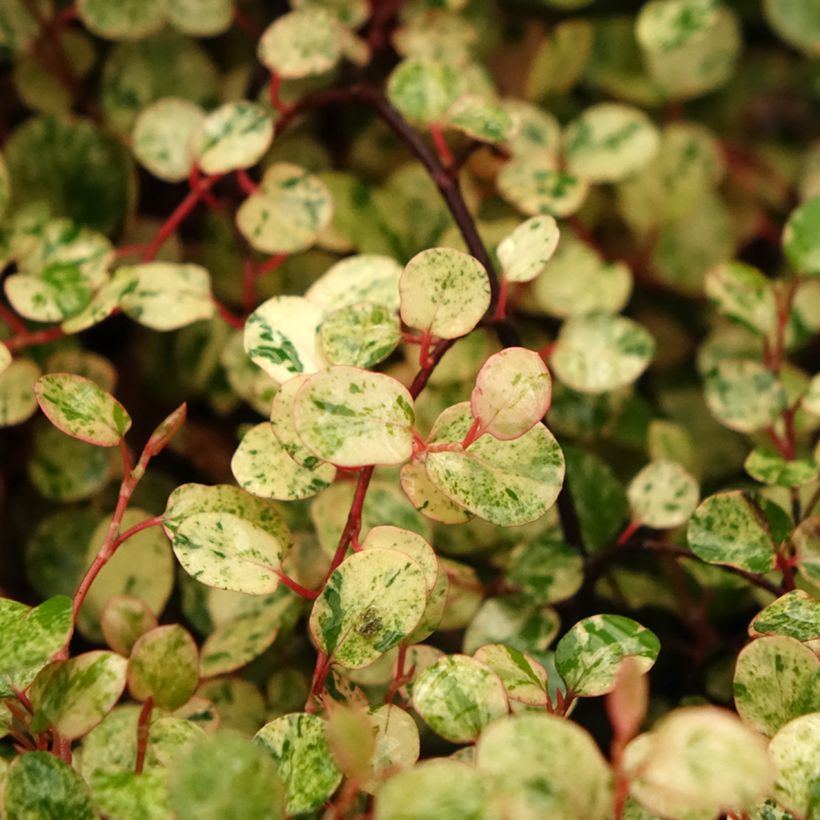

Pseudanthus tasmanicus Radiance
Pseudanthus tasmanicus Radiance
Pseudanthus tasmanicus Radiance 'MG02'
Creeping Muehlenbeckia
Special offer!
Receive a €20 voucher for any order over €90 (excluding delivery costs, credit notes, and plastic-free options)!
1- Add your favorite plants to your cart.
2- Once you have reached €90, confirm your order (you can even choose the delivery date!).
3- As soon as your order is shipped, you will receive an email containing your voucher code, valid for 3 months (90 days).
Your voucher is unique and can only be used once, for any order with a minimum value of €20, excluding delivery costs.
Can be combined with other current offers, non-divisible and non-refundable.
Home or relay delivery (depending on size and destination)
Schedule delivery date,
and select date in basket
This plant carries a 12 months recovery warranty
More information
We guarantee the quality of our plants for a full growing cycle, and will replace at our expense any plant that fails to recover under normal climatic and planting conditions.
Would this plant suit my garden?
Set up your Plantfit profile →
Description
The Pseudanthus tasmanicus 'Radiance' is an adorable ground cover, forming a carpet of round evergreen leaves, variegated with white and pink, on creeping stems. This colour intensifies in cold weather. Preferring slightly acidic, well-drained soils, it is best suited to mild climates as its hardiness does not exceed -7°C (19.4°F). However, it thrives in pots and hanging baskets, in full sun or partial shade.
The Pseudanthus is a small and rare genus that only grows in Australia and belongs to the equally unknown family of Picrodendraceae (previously classified among the Euphorbiaceae). The Pseudanthus tasmanicus, as its name suggests, originates from Tasmania - a southern island of Australia - and forms a dense ground cover with interlaced long stems, bearing small round or slightly oval evergreen leaves that effectively prevent the growth of "weeds". Under optimal conditions, the clump can reach 50 cm (20in) in height and 1 m (3ft) in spread.
The 'Radiance' variety has a beautiful foliage irregularly variegated with white and pink, very graphic, on reddish-pink stems. This colouring has the particularity of intensifying as temperatures decrease. Its flowering, rather insignificant, occurs in March and April, in the form of small white stars.
The Pseudanthus 'Radiance' prefers a slightly acidic, moist but well-drained soil, in moderately strong sunlight or partial shade. Given its origins, its hardiness is not excellent: avoid temperatures below -6 / -7°C (19.4°F). If you are fortunate to live in an area with a mild climate, use the Pseudanthus as a ground cover for your borders, moist rockeries, or slopes. If your winters are harsher, you can use it in a pot or hanging basket, where it will be very attractive with its long trailing stems. Simply water it regularly and bring it indoors to a sheltered and bright location during winter.
It may be useful to lightly prune it at the end of summer to densify it and enhance its colour by promoting new shoots.
Pair it with other oceanic plants, such as a ground cover at the base of a Lomatia myricoides, a Tristaniopsis, or a Eucalyptus niphophila with beautiful grey and green bark. Create a colour contrast by placing it at the foot of the Japanese maple 'Asahi Zuru' or the Zelkova 'Goshiki', small trees that also have foliage variegated with white and pink.
Report an error about the product description
Pseudanthus tasmanicus Radiance in pictures


Flowering
Foliage
Plant habit
Botanical data
Pseudanthus
tasmanicus
Radiance 'MG02'
Picrodendraceae
Creeping Muehlenbeckia
Australia
Other Ground cover perennials
View all →Planting and care
The Pseudanthus 'Radiance' requires a moist soil, preferably acidic to neutral, well-drained, in a very mild climate (avoid temperatures below -7°C (19.4°F)).
Planting period
Intended location
Care
This item has not been reviewed yet - be the first to leave a review about it.
Similar products
Haven't found what you were looking for?
Hardiness is the lowest winter temperature a plant can endure without suffering serious damage or even dying. However, hardiness is affected by location (a sheltered area, such as a patio), protection (winter cover) and soil type (hardiness is improved by well-drained soil).

Photo Sharing Terms & Conditions
In order to encourage gardeners to interact and share their experiences, Promesse de fleurs offers various media enabling content to be uploaded onto its Site - in particular via the ‘Photo sharing’ module.
The User agrees to refrain from:
- Posting any content that is illegal, prejudicial, insulting, racist, inciteful to hatred, revisionist, contrary to public decency, that infringes on privacy or on the privacy rights of third parties, in particular the publicity rights of persons and goods, intellectual property rights, or the right to privacy.
- Submitting content on behalf of a third party;
- Impersonate the identity of a third party and/or publish any personal information about a third party;
In general, the User undertakes to refrain from any unethical behaviour.
All Content (in particular text, comments, files, images, photos, videos, creative works, etc.), which may be subject to property or intellectual property rights, image or other private rights, shall remain the property of the User, subject to the limited rights granted by the terms of the licence granted by Promesse de fleurs as stated below. Users are at liberty to publish or not to publish such Content on the Site, notably via the ‘Photo Sharing’ facility, and accept that this Content shall be made public and freely accessible, notably on the Internet.
Users further acknowledge, undertake to have ,and guarantee that they hold all necessary rights and permissions to publish such material on the Site, in particular with regard to the legislation in force pertaining to any privacy, property, intellectual property, image, or contractual rights, or rights of any other nature. By publishing such Content on the Site, Users acknowledge accepting full liability as publishers of the Content within the meaning of the law, and grant Promesse de fleurs, free of charge, an inclusive, worldwide licence for the said Content for the entire duration of its publication, including all reproduction, representation, up/downloading, displaying, performing, transmission, and storage rights.
Users also grant permission for their name to be linked to the Content and accept that this link may not always be made available.
By engaging in posting material, Users consent to their Content becoming automatically accessible on the Internet, in particular on other sites and/or blogs and/or web pages of the Promesse de fleurs site, including in particular social pages and the Promesse de fleurs catalogue.
Users may secure the removal of entrusted content free of charge by issuing a simple request via our contact form.
The flowering period indicated on our website applies to countries and regions located in USDA zone 8 (France, the United Kingdom, Ireland, the Netherlands, etc.)
It will vary according to where you live:
- In zones 9 to 10 (Italy, Spain, Greece, etc.), flowering will occur about 2 to 4 weeks earlier.
- In zones 6 to 7 (Germany, Poland, Slovenia, and lower mountainous regions), flowering will be delayed by 2 to 3 weeks.
- In zone 5 (Central Europe, Scandinavia), blooming will be delayed by 3 to 5 weeks.
In temperate climates, pruning of spring-flowering shrubs (forsythia, spireas, etc.) should be done just after flowering.
Pruning of summer-flowering shrubs (Indian Lilac, Perovskia, etc.) can be done in winter or spring.
In cold regions as well as with frost-sensitive plants, avoid pruning too early when severe frosts may still occur.
The planting period indicated on our website applies to countries and regions located in USDA zone 8 (France, United Kingdom, Ireland, Netherlands).
It will vary according to where you live:
- In Mediterranean zones (Marseille, Madrid, Milan, etc.), autumn and winter are the best planting periods.
- In continental zones (Strasbourg, Munich, Vienna, etc.), delay planting by 2 to 3 weeks in spring and bring it forward by 2 to 4 weeks in autumn.
- In mountainous regions (the Alps, Pyrenees, Carpathians, etc.), it is best to plant in late spring (May-June) or late summer (August-September).
The harvesting period indicated on our website applies to countries and regions in USDA zone 8 (France, England, Ireland, the Netherlands).
In colder areas (Scandinavia, Poland, Austria...) fruit and vegetable harvests are likely to be delayed by 3-4 weeks.
In warmer areas (Italy, Spain, Greece, etc.), harvesting will probably take place earlier, depending on weather conditions.
The sowing periods indicated on our website apply to countries and regions within USDA Zone 8 (France, UK, Ireland, Netherlands).
In colder areas (Scandinavia, Poland, Austria...), delay any outdoor sowing by 3-4 weeks, or sow under glass.
In warmer climes (Italy, Spain, Greece, etc.), bring outdoor sowing forward by a few weeks.



















































